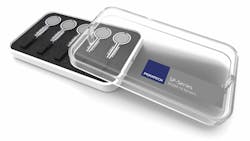Download this article in PDF format.
Adding pressure to a human-machine-interface (HMI) touch control can make it far more intuitive to use and allow it to recognize much more than simply “on” and “off.” With this new 3D information, a touch interface would recognize the difference between a touch and a tap. Adding a hard press, a light press, or a midway-between press to a touch interface means no more false activations. No more pocket dialing from your smartphone, if you will. And this is all achievable with quantum-tunnelling-composite (QTC) printed sensors.
QTC is a printable material that’s composed of conductive nanoparticles embedded in a polymer. QTC materials change resistance depending on variations in applied force, and could mean the end of fumbling with and swearing at your phone, oven, car console…the possibilities are endless.
What follows are a few myths regarding QTC printed sensors, and the real story behind each.
1. Printed sensors only work on solid surfaces.
QTC can be applied as a printable ink under almost any material that can translate force, whether the material is solid or flexible—materials such as glass, leather, wood, plastic, rubber, and metals. You can also consider the use of wood veneers, flexible OLEDs, and quantum-dot displays.
2. Printed sensors are limited only to flat surfaces.
Not only do QTC-based sensors work on flat surfaces, they can also be incorporated into single-radius, curved surfaces. If you desire a more flexible solution, you can also produce displays and interfaces with rollable or bendable surfaces. Likewise, ultra-thin, small, or odd-shaped surfaces are all possible options for designers.
3. Interfaces designed with QTC are operable only via human skin contact.
Not so! QTC-based printable sensors can be operated by touch, through gloves, with a stylus, or even with toothpicks and ballpoint pens.
4. Printed sensors aren’t durable or well-suited for harsh environments.
QTC is well-suited for almost any environment. QTC is an inert material that isn’t affected by humidity and can withstand a wide temperature range. QTC-based sensors have been tested to operate from ‒40°C up to 100°C and can replace traditional mechanical components, which are much less robust.
5. QTC-based sensors can be accidentally triggered.
QTC sensors function by changing resistance in proportion to force applied. Since they are analog by nature, the designer can define force thresholds for hard or light presses. In this case, not only can you detect tapping on the interface, but you can also determine the strength of the tapping. This measure of force opens up a large number of possibilities when designing a human-machine interface. Touch becomes 3D.
The figure shows an example of Peratech’s SP-Series single-point sensors.
6. Printed-sensor solutions are no different from standard load-cell designs.
QTC is formulated as an ink, so it can be screen-printed to create ultra-thin sensors and placed anywhere. Ultra-thin printing is QTC's shining star. Simple compression changes the resistance of the QTC sensor material, which has a raw analog response. In addition, QTC sensors are optimized for HMI applications between 0.1 and 20 N of force. They’re not ideal for measuring weight, though.
7. Printed sensors cannot be mass-produced with accuracy and reliability.
The QTC material can be deposited using standard screen-printing processes. Sensors can be produced with high sensitivity, high environmental sustainability, and a part-to-part repeatability with typically less than 5% variation in resistance per single batch. Much of the equipment needed in the production of QTC is currently in use to manufacture similar conventional components, such as touchscreens and computer trackpads.
8. Printable sensors are difficult to integrate into a design.
QTC sensors can be customized in a wide range of shapes and sizes to meet specific design requirements. Installation is often as simple as peel and stick, and almost any MCU with analog inputs can be used to read the sensors.
9. QTC sensors can’t measure position.
That’s incorrect! QTC sensors can be configured to measure an X-Y touch position as well as force in the Z-axis as pressure is applied. The response to pressure is predictable, repeatable, and consistent over time. QTC force sensors give designers the flexibility required to create optimal interfaces in response to evolving user demands.
10. Custom sensor solutions are expensive and not cost-effective.
QTC integration is relatively down-to-earth, but what about the costs of production? Printing, as opposed to mechanical HMI integration, can reduce tooling costs from millions to thousands of dollars. In most cases, you can use a standard QTC sensor in multiple product lines with only simple firmware changes and minor hardware tweaks. QTC is an extremely versatile material.
11. Designing with printed sensors requires a long development time.
We can counter this myth with a resounding “NO.” Most design firms have the technology in place to develop solutions using QTC sensors. The systems that are needed to print the sensors already exist in most manufacturing circles with simple adaptations for QTC production. QTC integrates with “hard” electronics very well. A standardized QTC sensor is flexible enough to be used in an entire line of products with minimal design changes. Last, but not least, design engineers would require minimal additional knowledge updating sensors to QTC. For instance, Peratech designs QTC sensors to integrate with your process.
About the Author
Mike Levin
Chief Commercial Officer
In his role as Chief Commercial Officer at Peratech, Mike’s wealth of experience commercializing human-machine-interface (HMI) solutions gives him unique insights into the challenges faced by innovators in the touch and force-sensing industry. He is committed to delivering high-performing, cost-effective prototypes with screen-printable Quantum Tunnelling Composite (QTC)-based force sensors, ensuring their environmental stability and long-term reliability. Mike has been awarded over 30 patents and authored numerous papers on haptics and robotics. He received a Bachelor of Science in aeronautical and avionics engineering and a Master of Science in mechanical engineering, both from the Massachusetts Institute of Technology (MIT).


